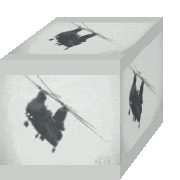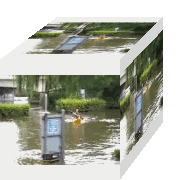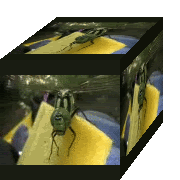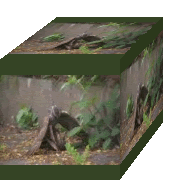 I don't know why this valuable land has been left unattended for so long, it's in the green belt so can't be built on, so maybe it's simply a small part of a wealthy portfolio, neither needed or noticed. Still, I don't mind as it's become a haven for nature and for me alike.
I don't know why this valuable land has been left unattended for so long, it's in the green belt so can't be built on, so maybe it's simply a small part of a wealthy portfolio, neither needed or noticed. Still, I don't mind as it's become a haven for nature and for me alike. Here in the new woods lies a derelict plant nursery. A good size plot with rows of greenhouse, boiler houses and offices. It seems strange, as if one day without warning everyone got up and left, never to return. Natures taken over, but in the greenery, exotic escapees lurk in the undergrowth.
Here in the new woods lies a derelict plant nursery. A good size plot with rows of greenhouse, boiler houses and offices. It seems strange, as if one day without warning everyone got up and left, never to return. Natures taken over, but in the greenery, exotic escapees lurk in the undergrowth. Out in the open grassland of what was horse pasture, lies the remnants of a trotting track laid out with old police cones.
Out in the open grassland of what was horse pasture, lies the remnants of a trotting track laid out with old police cones. There must be at least twenty of these, each one has a resident mouse.
There must be at least twenty of these, each one has a resident mouse. The yellow hue is caused by the colour of the cone and gives the dry, sheltered interior a cosy feel.
The yellow hue is caused by the colour of the cone and gives the dry, sheltered interior a cosy feel. A screech from the buzzard up in the nearby oak sends the little chap to huddle in the corner. Too small for a buzzard to be bothered with, the kestrel hovering in the distance is probably more of a threat, along with the obvious presence of owls, from the amount of pellets around.
A screech from the buzzard up in the nearby oak sends the little chap to huddle in the corner. Too small for a buzzard to be bothered with, the kestrel hovering in the distance is probably more of a threat, along with the obvious presence of owls, from the amount of pellets around.Inside the cone it is safe, dry, warmed by the sunshine. A little nest of fine grass occupies the corner, a secreted larder of seed in another....life is good in the police cone.
 My main reason for being here is to track a Muntjac. Small pockets of land such as this are perfect territory for these small deer. They are loners (or occasionally in small groups) and so can survive where larger deer and herds can't. About the size of an Alsatian dog, they love this mix of woodland with its undergrowth and tall grassland.
My main reason for being here is to track a Muntjac. Small pockets of land such as this are perfect territory for these small deer. They are loners (or occasionally in small groups) and so can survive where larger deer and herds can't. About the size of an Alsatian dog, they love this mix of woodland with its undergrowth and tall grassland. Muntjac are active day and night. They feed mainly at dawn and dusk, but can be found out and about at anytime. In the grassland there are many trails, ending in a circle of flattened foliage. These are lying up spots where they settle to ruminate.
Muntjac are active day and night. They feed mainly at dawn and dusk, but can be found out and about at anytime. In the grassland there are many trails, ending in a circle of flattened foliage. These are lying up spots where they settle to ruminate.
 My main reason for being here is to track a Muntjac. Small pockets of land such as this are perfect territory for these small deer. They are loners (or occasionally in small groups) and so can survive where larger deer and herds can't. About the size of an Alsatian dog, they love this mix of woodland with its undergrowth and tall grassland.
My main reason for being here is to track a Muntjac. Small pockets of land such as this are perfect territory for these small deer. They are loners (or occasionally in small groups) and so can survive where larger deer and herds can't. About the size of an Alsatian dog, they love this mix of woodland with its undergrowth and tall grassland.They are both secretive and elusive. Tracking them involves finding the extent of their territory and establishing their feeding routine, (they are creatures of habit, following the same route daily).
This track is recent, it was still today, but windy yesterday, so the small twig across the print would indicate that it is probably a day old.
 Muntjac are active day and night. They feed mainly at dawn and dusk, but can be found out and about at anytime. In the grassland there are many trails, ending in a circle of flattened foliage. These are lying up spots where they settle to ruminate.
Muntjac are active day and night. They feed mainly at dawn and dusk, but can be found out and about at anytime. In the grassland there are many trails, ending in a circle of flattened foliage. These are lying up spots where they settle to ruminate.This track is a little older, the sides have fallen in and is partly filled with bits from the overhead trees.
 Reeves's Muntjac/ Chinese Muntjac aren't indigenous. They were first brought into the country in 1840 at Woburn Abbey. Many escaped later from Whipsnade Zoo in Bedfordshire and they have slowly established themselves across the country. The Midlands seems to particularly suit them, with it's mix of habitat.
Reeves's Muntjac/ Chinese Muntjac aren't indigenous. They were first brought into the country in 1840 at Woburn Abbey. Many escaped later from Whipsnade Zoo in Bedfordshire and they have slowly established themselves across the country. The Midlands seems to particularly suit them, with it's mix of habitat.
 Reeves's Muntjac/ Chinese Muntjac aren't indigenous. They were first brought into the country in 1840 at Woburn Abbey. Many escaped later from Whipsnade Zoo in Bedfordshire and they have slowly established themselves across the country. The Midlands seems to particularly suit them, with it's mix of habitat.
Reeves's Muntjac/ Chinese Muntjac aren't indigenous. They were first brought into the country in 1840 at Woburn Abbey. Many escaped later from Whipsnade Zoo in Bedfordshire and they have slowly established themselves across the country. The Midlands seems to particularly suit them, with it's mix of habitat.This is a track from today, clean and crisp, I'm slowly figuring out the route this chap takes.
Muntjacs are one of the oldest known deer, appearing nearly 30 million years ago. They are unusual as they have no rutting period and will breed at any time of year, this must lend to their success at spreading across the country as it allows them to be flexible in their territories.
It looks as if this individual has taken peoples back gardens into its territory, (they'll often browse bird feeders).
I'd just switched my camcorder off and then there it was. I had to wait for the camera to fire back up which seemed to take an age. The wind was in my favour, luckily. This is a doe, you can tell by the lack of antlers, just little tufts instead. Bucks lose their small antlers in May/June but by now they would have been replaced. They spend a lot of time in scrubby woodland with a lot of undergrowth, large antlers would be a hindrance. Rather than using them to fight, they are used to overbalance the opposition and then the tusk like canines are used aggressively.
Keep your eyes open these little chaps are all around us. They can be mistaken for a dog or a fox crossing a field in the distance. If you suspect that they are coming into your garden, put some finely raked soil around where they might feed and look for tracks.






10 comments:
That little deer is adorable! I had never seen one, thanks for posting it!
Those little mice are so cute in those cones! and I have never seen that type of deer. Great video!
Wow! Ive never seen a Muntjack - had never heard of them either LOL! Fascinating creatures, so small - I can see how theyd be mistaken for other critters...Well stalked Mate!!!
The mice in the cones, how adorable! What great little houses they make.
Great Post Barkfoot!!
I've never heard of them either.... are they in the US as well?
um.......any British accent is fine, I am not picky
I am so glad that you got that footage of the little muntjack. Seeing the footprint and how small it was, I thought to myself, 'I hope he got a pic of one...' You had me curious to see how small one is.
And the mice! too cute. We have a little one in our garage that its the dog food. I have been on my husband to set the traps... now after seeing this, I am compelled to put some good food out for the little sweet creature.
Thanks Barky
;)
Now, I am going to have a bunch of little mice running around in my garage... giggle
As always, your post are so informative. I always enjoy them!
the mouse "eats" the dog food...
not "its"
lol!
oh I like this post...
we found a small mouse when we were looking for mushrooms but the photo was blurry. I didn't know about those deer... I haven't heard about them in this part of the country... are they here in the Bristol area as well?
Fascinating post Barkfoot. Well captured mice and tracking job. I haven't seen that type of deer before either. As someone asked are they in the US too?
OMG just the sight of that mouse scares me, even in its natural habitat!
Secret Agent/ Photowannabe - I don't think that there are any colonies in the USA...Sorry.
Madwag - Yes, you should have some local Muntjac. They have colonised most of Southern England and as far north as Derbyshire, there are a few even further north but those are thought to be deliberate introductions. Listen out for a strange 'barking' call, often as the sun is setting.
Post a Comment